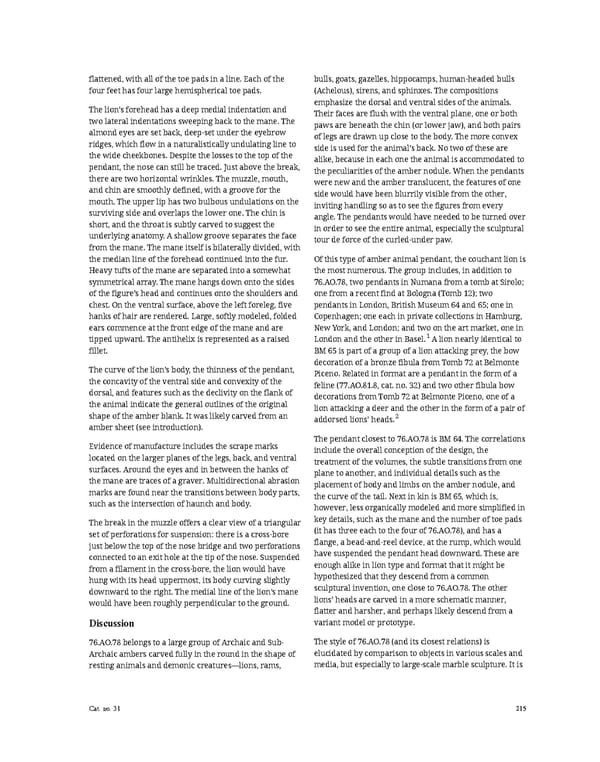flattened, with all of the toe pads in a line. Each of the bulls, goats, gazelles, hippocamps, human-headed bulls four feet has four large hemispherical toe pads. (Achelous), sirens, and sphinxes. The compositions emphasize the dorsal and ventral sides of the animals. The lion’s forehead has a deep medial indentation and Their faces are flush with the ventral plane, one or both two lateral indentations sweeping back to the mane. The paws are beneath the chin (or lower jaw), and both pairs almond eyes are set back, deep-set under the eyebrow of legs are drawn up close to the body. The more convex ridges, which flow in a naturalistically undulating line to side is used for the animal’s back. No two of these are the wide cheekbones. Despite the losses to the top of the alike, because in each one the animal is accommodated to pendant, the nose can still be traced. Just above the break, the peculiarities of the amber nodule. When the pendants there are two horizontal wrinkles. The muzzle, mouth, were new and the amber translucent, the features of one and chin are smoothly defined, with a groove for the side would have been blurrily visible from the other, mouth. The upper lip has two bulbous undulations on the inviting handling so as to see the figures from every surviving side and overlaps the lower one. The chin is angle. The pendants would have needed to be turned over short, and the throat is subtly carved to suggest the in order to see the entire animal, especially the sculptural underlying anatomy. A shallow groove separates the face tour de force of the curled-under paw. from the mane. The mane itself is bilaterally divided, with the median line of the forehead continued into the fur. Of this type of amber animal pendant, the couchant lion is Heavy tufts of the mane are separated into a somewhat the most numerous. The group includes, in addition to symmetrical array. The mane hangs down onto the sides 76.AO.78, two pendants in Numana from a tomb at Sirolo; of the figure’s head and continues onto the shoulders and one from a recent find at Bologna (Tomb 12); two chest. On the ventral surface, above the left foreleg, five pendants in London, British Museum 64 and 65; one in hanks of hair are rendered. Large, softly modeled, folded Copenhagen; one each in private collections in Hamburg, ears commence at the front edge of the mane and are New York, and London; and two on the art market, one in tipped upward. The antihelix is represented as a raised London and the other in Basel.1 A lion nearly identical to fillet. BM 65 is part of a group of a lion attacking prey, the bow decoration of a bronze fibula from Tomb 72 at Belmonte The curve of the lion’s body, the thinness of the pendant, Piceno. Related in format are a pendant in the form of a the concavity of the ventral side and convexity of the feline (77.AO.81.8, cat. no. 32) and two other fibula bow dorsal, and features such as the declivity on the flank of decorations from Tomb 72 at Belmonte Piceno, one of a the animal indicate the general outlines of the original lion attacking a deer and the other in the form of a pair of shape of the amber blank. It was likely carved from an addorsed lions’ heads.2 amber sheet (see introduction). The pendant closest to 76.AO.78 is BM 64. The correlations Evidence of manufacture includes the scrape marks include the overall conception of the design, the located on the larger planes of the legs, back, and ventral treatment of the volumes, the subtle transitions from one surfaces. Around the eyes and in between the hanks of plane to another, and individual details such as the the mane are traces of a graver. Multidirectional abrasion placement of body and limbs on the amber nodule, and marks are found near the transitions between body parts, the curve of the tail. Next in kin is BM 65, which is, such as the intersection of haunch and body. however, less organically modeled and more simplified in The break in the muzzle offers a clear view of a triangular key details, such as the mane and the number of toe pads set of perforations for suspension: there is a cross-bore (it has three each to the four of 76.AO.78), and has a just below the top of the nose bridge and two perforations flange, a bead-and-reel device, at the rump, which would connected to an exit hole at the tip of the nose. Suspended have suspended the pendant head downward. These are from a filament in the cross-bore, the lion would have enough alike in lion type and format that it might be hung with its head uppermost, its body curving slightly hypothesized that they descend from a common downward to the right. The medial line of the lion’s mane sculptural invention, one close to 76.AO.78. The other would have been roughly perpendicular to the ground. lions’ heads are carved in a more schematic manner, flatter and harsher, and perhaps likely descend from a Discussion variant model or prototype. 76.AO.78 belongs to a large group of Archaic and Sub- The style of 76.AO.78 (and its closest relations) is Archaic ambers carved fully in the round in the shape of elucidated by comparison to objects in various scales and resting animals and demonic creatures—lions, rams, media, but especially to large-scale marble sculpture. It is Cat. no. 31 215
 Ancient Carved Ambers in the J. Paul Getty Museum Page 224 Page 226
Ancient Carved Ambers in the J. Paul Getty Museum Page 224 Page 226